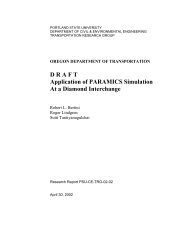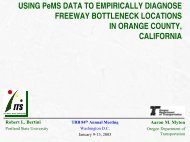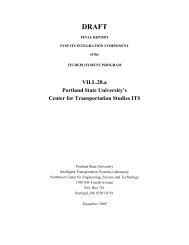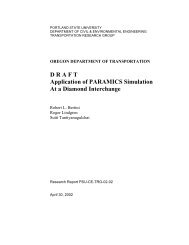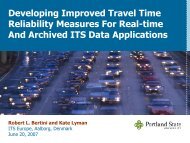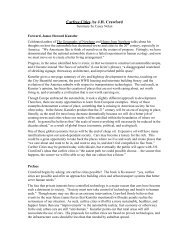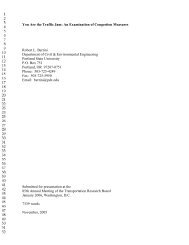Generating Transit Performance Measures with ... - Transportation
Generating Transit Performance Measures with ... - Transportation
Generating Transit Performance Measures with ... - Transportation
You also want an ePaper? Increase the reach of your titles
YUMPU automatically turns print PDFs into web optimized ePapers that Google loves.
Bertini and El-Geneidy Paper No. 03- 4393 119<br />
Actual Scheduled Passengers<br />
12<br />
Number of Buses Passing Through the Stop<br />
20<br />
15<br />
10<br />
5<br />
10<br />
8<br />
6<br />
4<br />
2<br />
Number of Passengers<br />
0<br />
0<br />
15:36:00 15:50:24 16:04:48 16:19:12 16:33:36 16:48:00 17:02:24 17:16:48<br />
Time<br />
FIGURE 10<br />
On-time performance at stop at Hawthorne and 39th Avenue.<br />
Most significantly, TriMet had the foresight to develop a system<br />
to archive all of its stop-level data, which are then available for conversion<br />
to performance indicators. This paper demonstrates the<br />
powerful ways that the data collected by the BDS can be converted<br />
into potentially valuable TPMs. These TPMs have been proposed in<br />
the past but were not implemented owing to data limitations. It is<br />
envisioned that systematic use of TPMs can assist a transit agency<br />
in improving the quality and reliability of its service, leading to<br />
improvements for customers and operators alike.<br />
The value of such an ongoing generator of performance data is that<br />
it eliminates the need to make assumptions and estimates about<br />
time-varying behavior that find their way into aggregate performance<br />
metrics. The TriMet BDS data are being archived every day, so longterm<br />
averages can be calculated rather than estimated. The next step<br />
in this research will be to introduce these and other performance measures<br />
to TriMet and other transit properties and to test their usefulness<br />
to planners, schedulers, and dispatchers. It is conceivable that<br />
some of these measures could be generated automatically each day<br />
for later analysis and research. By getting performance information<br />
into the hands of the transit agency employees, and providing them<br />
<strong>with</strong> tools to help them perform their jobs more effectively, it is<br />
likely that an agency will be able to see measurable improvements<br />
in a relatively short time.<br />
ACKNOWLEDGMENTS<br />
The authors thank Steve Callas of TriMet for providing the data used.<br />
Thomas Kimpel and James Strathman of the Center for Urban Studies<br />
at Portland State University also assisted <strong>with</strong> data acquisition and<br />
provided valuable comments along the way. Sutti Tantiyanugulchai<br />
and Shazia Malik assisted <strong>with</strong> data processing and analysis. Portions<br />
of this work were funded by Portland State University Center for<br />
Urban Studies and the Department of Civil and Environmental Engineering.<br />
Finally, the authors thank Herbert Levinson and the anonymous<br />
reviewers whose valuable comments improved this paper<br />
considerably.<br />
REFERENCES<br />
1. Changing Faces of <strong>Transportation</strong>. BTS00-007. Bureau of <strong>Transportation</strong><br />
Statistics, U.S. Department of <strong>Transportation</strong>, 2000.<br />
2. Web Document No. 6: <strong>Transit</strong> Capacity and Quality of Service Manual.<br />
TCRP, TRB, National Research Council, Washington, D.C., 1999.<br />
3. NCHRP Research Results Digest 226: Multimodal <strong>Transportation</strong> Development<br />
of a <strong>Performance</strong>-Based Planning Process. TRB, National<br />
Research Council, Washington, D.C., 1999.<br />
4. Fielding, G. J. Managing Public <strong>Transit</strong> Strategically: A Comprehensive<br />
Approach to Strengthening Service and Monitoring <strong>Performance</strong>. Jossey-<br />
Bass, San Francisco, Calif., 1987.<br />
5. Fielding, G. J. <strong>Transit</strong> <strong>Performance</strong> Evaluation in the U.S.A. <strong>Transportation</strong><br />
Research, Vol. 26A, No. 6, 1992, pp. 483–491.<br />
6. Strathman, J. G., T. J. Kimpel, K. J. Dueker, R. L. Gerhart, K. Turner,<br />
D. Griffin, and S. Callas. Bus <strong>Transit</strong> Operation Control: Review and an<br />
Experiment Involving TriMet’s Automated Bus Dispatching System.<br />
Journal of Public <strong>Transportation</strong>, Vol. 4, No. 1, 2001, pp. 1–26.<br />
7. Levinson, H. W. Synthesis of <strong>Transit</strong> Practice 15: Supervision Strategies<br />
for Improved Reliability of Bus Routes. TRB, National Research Council,<br />
Washington, D.C., 1991.<br />
8. Klein, D. B., A. T. Moore, and R. Binyamen. Curb Rights, A Foundation<br />
for Free Enterprise in Urban <strong>Transit</strong>. Brooking Institution Press,<br />
Washington, D.C., 1997.<br />
Publication of this paper sponsored by Task force on <strong>Transit</strong> Capacity and Quality<br />
of Service.



